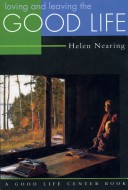Good Life
4 total works
Fifty years before the phrase "simple living" became fashionable, Helen and Scott Nearing were living their celebrated "Good Life" on homesteads first in Vermont, then in Maine. All the way to their ninth decades, the Nearings grew their own food, built their own buildings, and fought an eloquent combat against the silliness of America's infatuation with consumer goods and refined foods. They also wrote or co-wrote more than thirty books, many of which are now being brought back into print by the Good Life Center and Chelsea Green.
Simple Food for the Good Life is a jovial collection of "quips, quotes, and one-of-a-kind recipes meant to amuse and intrigue all of those who find themselves in the kitchen, willingly or otherwise." Recipes such as Horse Chow, Scott's Emulsion, Crusty Carrot Croakers, Raw Beet Borscht, Creamy Blueberry Soup, and Super Salad for a Crowd should improve the mood as well as whet the appetite of any guest.
Here is an antidote for the whole foods enthusiast who is "fed up" with the anxieties and drudgeries of preparing fancy meals with stylish, expensive, hard-to-find ingredients. This celebration of salads, leftovers, raw foods, and homegrown fruits and vegetables takes the straightest imaginable route from their stem or vine to your table.
"The funniest, crankiest, most ambivalent cookbook you'll ever read," said Food & Wine magazine. "This is more than a mere cookbook," said Health Science magazine: "It belongs to the category of classics, destined to be remembered through the ages."
Among Helen Nearing's numerous books is Chelsea Green's Loving and Leaving the Good Life, a memoir of her fifty-year marriage to Scott Nearing and the story of Scott's deliberate death at the age of one hundred. Helen and Scott Nearing's final homestead in Harborside, Maine, has been established in perpetuity as an educational progam under the name of The Good Life Center.
A half-century ago, the world was trying to heal the wounds of global war. People were rushing to make up for lost time, grasping for material wealth. This was the era of "total electric living," a phrase beamed into living rooms by General Electric spokesman Ronald Reagan. Environmental awareness was barely a gleam in the eye of even Rachel Carson.
And yet, Helen and Scott Nearing were on a totally different path, having left the city for the country, eschewing materialistic society in a quest for the self-sufficiency they deemed "the Good Life." Chelsea Green is pleased to honor their example by publishing a new edition of The Maple Sugar Book, complete with a new section of never-before-published photos of the Nearings working on the sugaring operation, and an essay by Greg Joly relating the story behind the book and placing the Nearings' work in the context of their neighborhood and today's maple industry.
Maple sugaring was an important source of cash for the Nearings, as it continues to be for many New England farmers today. This book is filled with a history of sugaring from Native American to modern times, with practical tips on how to sap trees, process sap, and market syrup. In an age of microchips and software that are obsolete before you can install them, maple sugaring is a process that's stood the test of time. Fifty years after its original publication in 1950, The Maple Sugar Book is as relevant as ever to the homestead or small-scale commercial practitioner.
Scott Nearing lived one hundred years, from 1883 to 1983--a life spanning most of the twentieth century. In his early years, Nearing made his name as a formidable opponent of child labour and military imperialism. Having been fired from university jobs for his independence of mind, Nearing became a freelance lecturer and writer, traveling widely through Depression-era and post-war America to speak with eager audiences. Five-time Socialist candidate for president Eugene V. Debs said, "Scott Nearing! He is the greatest teacher in the United States."
Concluding that it would be better to be poor in the country than in New York City, Scott and Helen Nearing moved north to Vermont in 1932 and commenced the experiment in self-reliant living that would extend their fame far and wide. They began to grow most of their own food, and devised their famous scheme for allocating the day's hours: one third for "bread work" (livelihood), one third for "head work" (intellectual endeavors), and one third for "service to the world community." Scott (who'd grown up partly on his grandfather's Pennsylvania farm) taught Helen (who was raised in suburbia, groomed for a career as a classical violinist) the practical skills they would need: working with tools, cultivating a garden and managing a woodlot, and building stone and masonry walls.
For the rest of their lives, the Nearings chronicled in detail their "good life," first in Vermont and ultimately on the coast of Maine, in a group of wonderful books--many of which are now being returned to print by Chelsea Green in cooperation with the Good Life Center, an educational trust established at the Nearings' Forest Farm in Harborside, Maine, to promote their ongoing legacy.
With a new foreword by activist historian Staughton Lynd, The Making of a Radical is freshly republished-Scott Nearing's own story, told as only he could tell it.
Helen and Scott Nearing, authors of Living the Good Life and many other bestselling books, lived together for 53 years until Scott's death at age 100. Loving and Leaving the Good Life is Helen's testimonial to their life together and to what they stood for: self-sufficiency, generosity, social justice, and peace.
In 1932, after deciding it would be better to be poor in the country than in the city, Helen and Scott moved from New York Ciy to Vermont. Here they created their legendary homestead which they described in Living the Good Life: How to Live Simply and Sanely in a Troubled World, a book that has sold 250,000 copies and inspired thousands of young people to move back to the land.
The Nearings moved to Maine in 1953, where they continued their hard physical work as homesteaders and their intense intellectual work pormoting social justice. Thirty years later, as Scott approached his 100th birthday, he decided it was time to prepare for his death. He stopped eating, and six weeks later Helen held him and said goodbye.
Loving and Leaving the Good Life is a vivid self-portrait of an independent, committed and gifted woman. It is also an eloquent statement of what it means to grow old and to face death quietly, peacefully, and in control. At 88, Helen seems content to be nearing the end of her good life. As she puts it, "To have partaken of and to have given love is the greatest of life's rewards. There seems never an end to the loving that goes on forever and ever. Loving and leaving are part of living."
Helen's death in 1995 at the age of 92 marks the end of an era. Yet as Helen writes in her remarkable memoir, "When one door closes, another opens." As we search for a new understanding of the relationships between death and life, this book provides profound insights into the question of how we age and die.


